Detection of Atrial Fibrillation Using Multi-Site Ballistocardiogram with Piezoelectric Rubber Sheet Sensors
Highlights
- An algorithm to detect atrial fibrillation was developed, which worked with a ballistocardiogram recorded using sensors placed at various locations from the head to the lumbar region.
- Combined assessment using multiple sensors improved the accuracy.
- This algorithm is tolerant of the misalignment of the body relative to the sensor from the head to the lumbar region.
- This model is valuable for practical applications as it accommodates body movements during sleep.
Abstract
1. Introduction
2. Materials and Methods
2.1. Study Participants
2.2. Recording of BCG
2.3. Principle of the Piezoelectric Rubber Sheet Sensor
2.4. Recording of ECG and Respiration Signals
2.5. Preprocessing Data
2.6. Data Composition
2.7. Machine Learning Classifiers
2.8. Statistical Analysis
3. Results
3.1. Comparison of BCG Signals Between Participants with and Without AF
3.2. Optimization of ML Classifiers
3.3. Removal of External Noise
3.4. Testing of Optimized ML Classifiers
3.5. Influence of Location of BCG Sensors on Detection of AF
3.6. Combining BCG Data Recorded at Multiple Locations
4. Discussion
5. Conclusions
Author Contributions
Funding
Institutional Review Board Statement
Informed Consent Statement
Data Availability Statement
Acknowledgments
Conflicts of Interest
Abbreviations
| AF | Atrial fibrillation |
| BCG | Ballistocardiogram |
| ML | Machine learning |
| AUC | Area under the curve |
| FFT | Fast Fourier transform |
| DT | Decision tree classifier |
| RF | Random forest classifier |
| LR | Logistic regression |
| ADA | AdaBoost classifier |
| CV | Cross validation |
| ROC | Receiver operating characteristic |
References
- Joglar, J.A.; Chung, M.K.; Armbruster, A.L.; Benjamin, E.J.; Chyou, J.Y.; Cronin, E.M.; Deswal, A.; Eckhardt, L.L.; Goldberger, Z.D.; Gopinathannair, R.; et al. 2023 ACC/AHA/ACCP/HRS guideline for the diagnosis and management of atrial fibrillation: A report of the American College of Cardiology/American Heart Association Joint Committee on Clinical Practice Guidelines. Circulation 2024, 149, e1–e156. [Google Scholar] [CrossRef]
- Willems, S.; Borof, K.; Brandes, A.; Breithardt, G.; Camm, A.J.; Crijns, H.; Eckardt, L.; Gessler, N.; Goette, A.; Haegeli, L.M.; et al. Systematic, early rhythm control strategy for atrial fibrillation in patients with or without symptoms: The EAST-AFNET 4 trial. Eur. Heart J. 2022, 43, 1219–1230. [Google Scholar] [CrossRef]
- Gladstone, D.J.; Spring, M.; Dorian, P.; Panzov, V.; Thorpe, K.E.; Hall, J.; Vaid, H.; O’Donnell, M.; Laupacis, A.; Côté, R.; et al. Atrial fibrillation in patients with cryptogenic stroke. N. Engl. J. Med. 2014, 370, 2467–2477. [Google Scholar] [CrossRef]
- Kim, J.Y.; Oh, I.Y.; Lee, H.; Lee, J.H.; Cho, Y.; Gil, Y.; Jung, S.; Kim, D.I.; Shin, M.G.; Yoo, J.Y.; et al. The efficacy of detecting arrhythmia is higher with 7-day continuous electrocardiographic patch monitoring than with 24-h Holter monitoring. J. Arrhythm. 2023, 39, 422–429. [Google Scholar] [CrossRef]
- Karaoğuz, M.R.; Yurtseven, E.; Aslan, G.; Deliormanlı, B.G.; Adıgüzel, Ö.; Gönen, M.; Li, K.M.; Yılmaz, E.N. The quality of ECG data acquisition, and diagnostic performance of a novel adhesive patch for ambulatory cardiac rhythm monitoring in arrhythmia detection. J. Electrocardiol. 2019, 54, 28–35. [Google Scholar] [CrossRef]
- Gladstone, D.J.; Wachter, R.; Schmalstieg-Bahr, K.; Quinn, F.R.; Hummers, E.; Ivers, N.; Marsden, T.; Thornton, A.; Djuric, A.; Suerbaum, J.; et al. Screening for atrial fibrillation in the older population: A randomized clinical trial. JAMA Cardiol. 2021, 6, 558–567. [Google Scholar] [CrossRef] [PubMed]
- Pinheiro, E.; Postolache, O.; Girão, P. Theory and developments in an unobtrusive cardiovascular system representation: Ballistocardiography. Open Biomed. Eng. J. 2010, 4, 201–216. [Google Scholar] [CrossRef]
- Sadek, I.; Biswas, J.; Abdulrazak, B. Ballistocardiogram signal processing: A review. Health Inf. Sci. Syst. 2019, 7, 10. [Google Scholar] [CrossRef]
- Jiang, F.; Zhou, Y.; Ling, T.; Zhang, Y.; Zhu, Z. Recent research for unobtrusive atrial fibrillation detection methods based on cardiac dynamics signals: A survey. Sensors 2021, 21, 3814. [Google Scholar] [CrossRef] [PubMed]
- Zink, M.D.; Brüser, C.; Winnersbach, P.; Napp, A.; Leonhardt, S.; Marx, N.; Schauerte, P.; Mischke, K. Heartbeat cycle length detection by a ballistocardiographic sensor in atrial fibrillation and sinus rhythm. Biomed. Res. Int. 2015, 2015, 840356. [Google Scholar] [CrossRef] [PubMed]
- Feng, J.; Huang, W.; Jiang, J.; Wang, Y.; Zhang, X.; Li, Q.; Jiao, X. Non-invasive monitoring of cardiac function through ballistocardiogram: An algorithm integrating short-time Fourier transform and ensemble empirical mode decomposition. Front. Physiol. 2023, 14, 1201722. [Google Scholar] [CrossRef]
- Koivisto, T.; Lahdenoja, O.; Koskinen, J.; Panula, T.; Hurnanen, T.; Kaisti, M.; Kinnunen, J.; Kostiainen, P.; Meriheinä, U.; Vasankari, T.; et al. Atrial fibrillation detection using MEMS accelerometer based bedsensor. Comput. Cardiol. 2019, 46, 1–4. [Google Scholar] [CrossRef]
- Jiang, F.; Hong, C.; Cheng, T.; Wang, H.; Xu, B.; Zhang, B. Attention-based multi-scale features fusion for unobtrusive atrial fibrillation detection using ballistocardiogram signal. BioMed Eng. OnLine 2021, 20, 12. [Google Scholar] [CrossRef] [PubMed]
- Cheng, T.; Jiang, F.; Li, Q.; Zeng, J.; Zhang, B. Quantitative analysis using consecutive time window for unobtrusive atrial fibrillation detection based on ballistocardiogram signal. Sensors 2022, 22, 5516. [Google Scholar] [CrossRef] [PubMed]
- Sandelin, J.; Lahdenoja, O.; Elnaggar, I.; Rekola, R.; Anzanpour, A.; Seifizarei, S.; Kaisti, M.; Koivisto, T.; Lehto, J.; Nuotio, J.; et al. Bed sensor ballistocardiogram for non-invasive detection of atrial fibrillation: A comprehensive clinical study. Physiol. Meas. 2025, 46, 035300. [Google Scholar] [CrossRef] [PubMed]
- Huang, S.; Gao, Y.; Hu, Y.; Shen, F.; Jin, Z.; Cho, Y. Recent development of piezoelectric biosensors for physiological signal detection and machine learning assisted cardiovascular disease diagnosis. RSC Adv. 2023, 13, 29174–29194. [Google Scholar] [CrossRef]
- Hayano, J.; Yamamoto, H.; Tanaka, H.; Yuda, E. Piezoelectric rubber sheet sensor: A promising tool for home sleep apnea testing. Sleep Breath. 2024, 28, 1273–1283. [Google Scholar] [CrossRef]
- Kao, W.F.; Hou, S.K.; Huang, C.Y.; Chao, C.C.; Cheng, C.C.; Chen, Y.J. Assessment of the clinical efficacy of the heart spectrum blood pressure monitor for diagnosis of atrial fibrillation: An unblinded clinical trial. PLoS ONE 2018, 13, e0198852. [Google Scholar] [CrossRef]
- Jafari Tadi, M.; Mehrang, S.; Kaisti, M.; Lahdenoja, O.; Hurnanen, T.; Jaakkola, J.; Jaakkola, S.; Vasankari, T.; Kiviniemi, T.; Airaksinen, J.; et al. Comprehensive analysis of cardiogenic vibrations for automated detection of atrial fibrillation using smartphone mechanocardiograms. IEEE Sens. J. 2019, 19, 2230–2242. [Google Scholar] [CrossRef]
- Pachori, D.; Tripathy, R.; Jain, T. Detection of atrial fibrillation from PPG sensor data using variational mode decomposition. IEEE Sens. Lett. 2024, 8, 6001904. [Google Scholar] [CrossRef]
- Liu, X.; Liu, H.; Li, J.; Yang, Z.; Huang, Y.; Zhang, J. AcousAF: Acoustic sensing-based atrial fibrillation detection system for mobile phones. In Proceedings of the Companion of the 2024 on ACM International Joint Conference on Pervasive and Ubiquitous Computing, Melbourne, Australia, 5–9 October 2024; pp. 377–383. [Google Scholar] [CrossRef]
- Zhao, L.; Lyu, R.; Lin, Q.; Zhou, A.; Zhang, H.; Ma, H.; Wang, J.; Shao, C.; Tang, Y. mmArrhythmia: Contactless arrhythmia detection via mmWave sensing. Proc. ACM Interact. Mob. Wearable Ubiquitous Technol. 2024, 8, 30. [Google Scholar] [CrossRef]
- Inoue, H.; Fujiki, A.; Origasa, H.; Ogawa, S.; Okumura, K.; Kubota, I.; Aizawa, Y.; Yamashita, T.; Atarashi, H.; Horie, M.; et al. Prevalence of atrial fibrillation in the general population of Japan: An analysis based on periodic health examination. Int. J. Cardiol. 2009, 137, 102–107. [Google Scholar] [CrossRef] [PubMed]
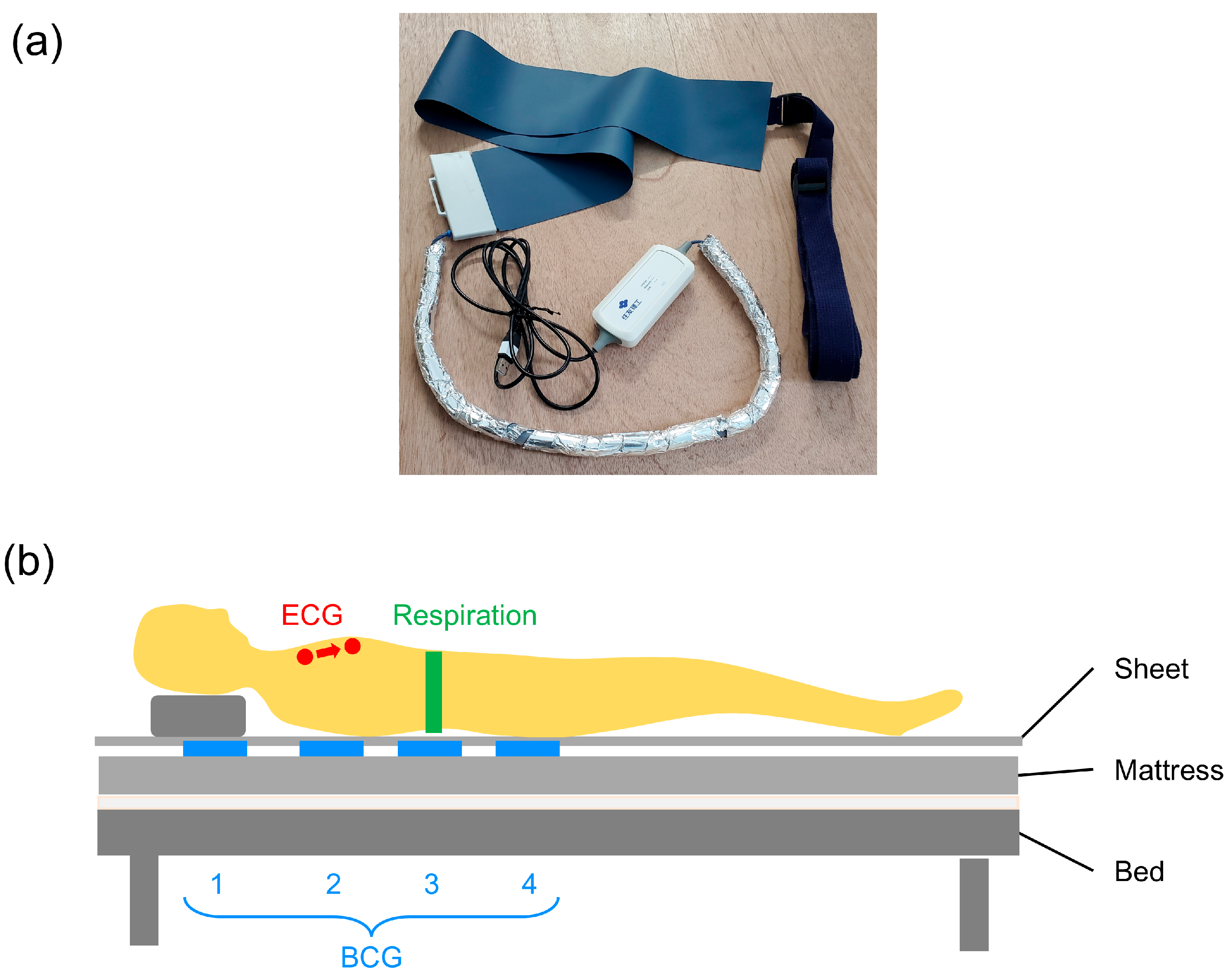




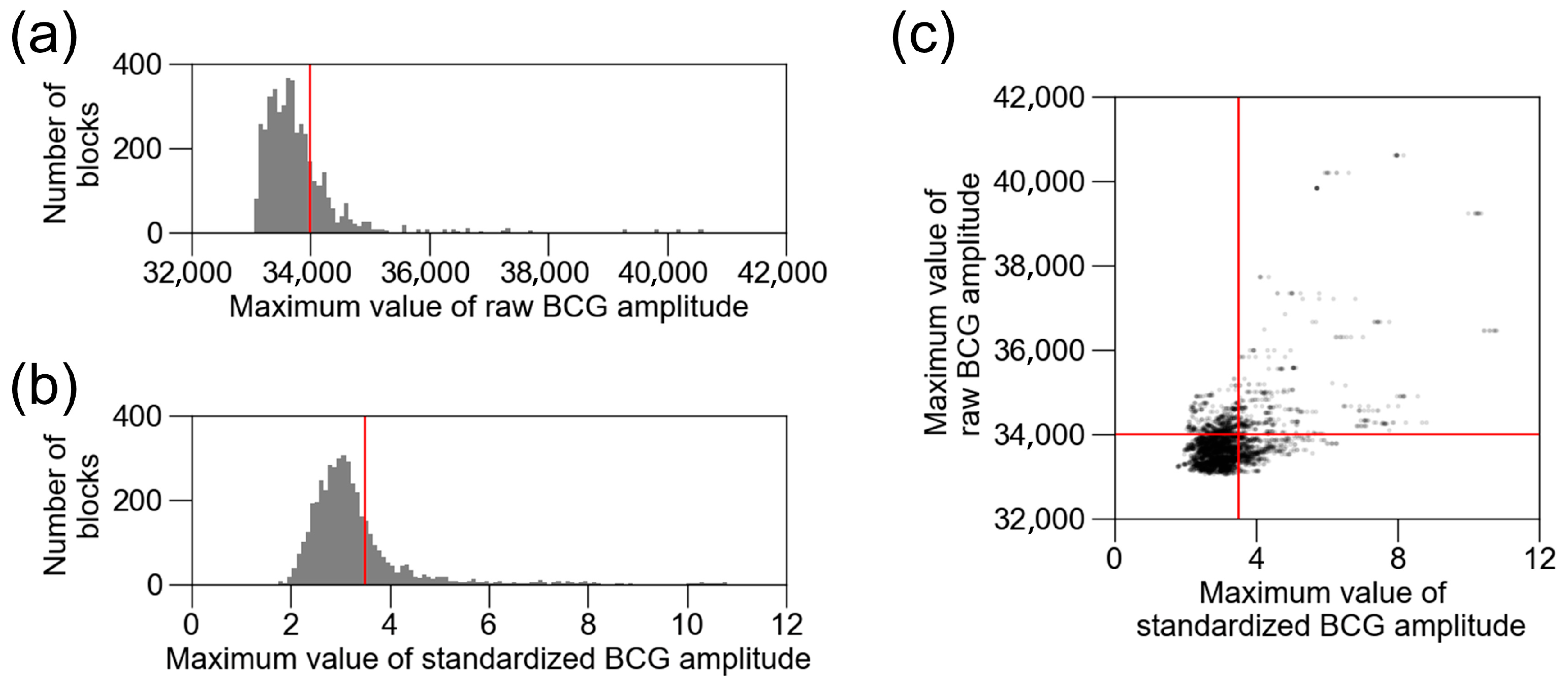
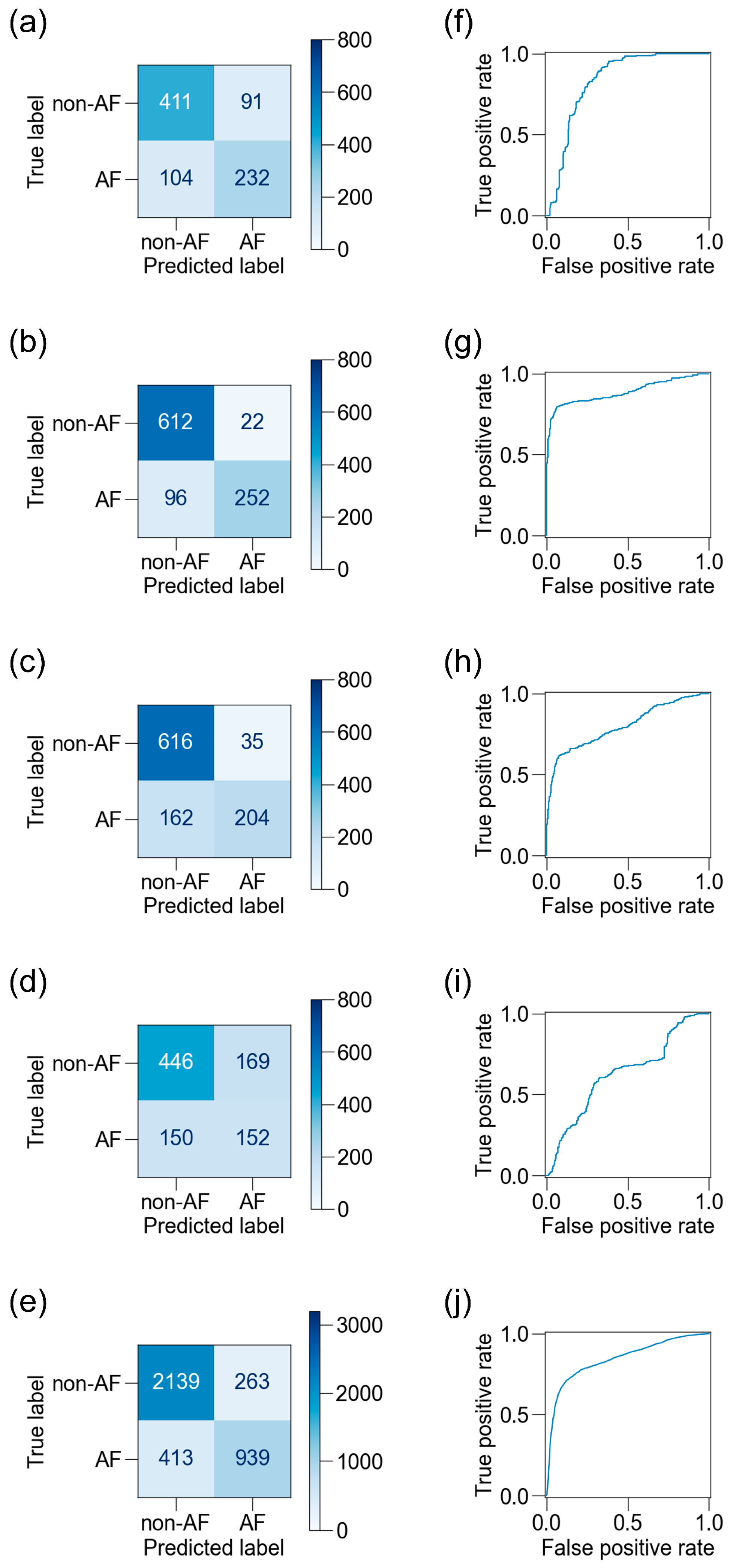
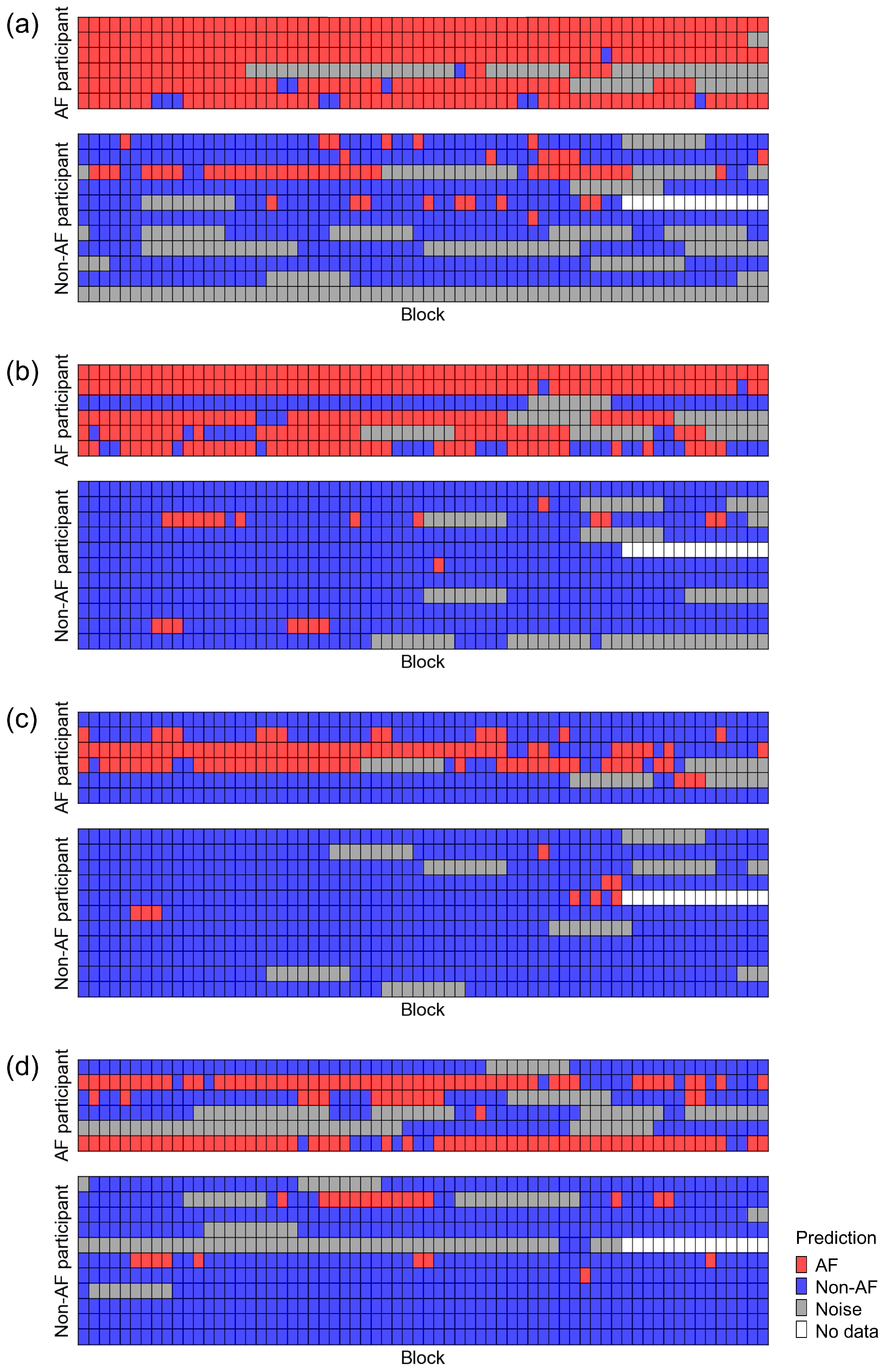

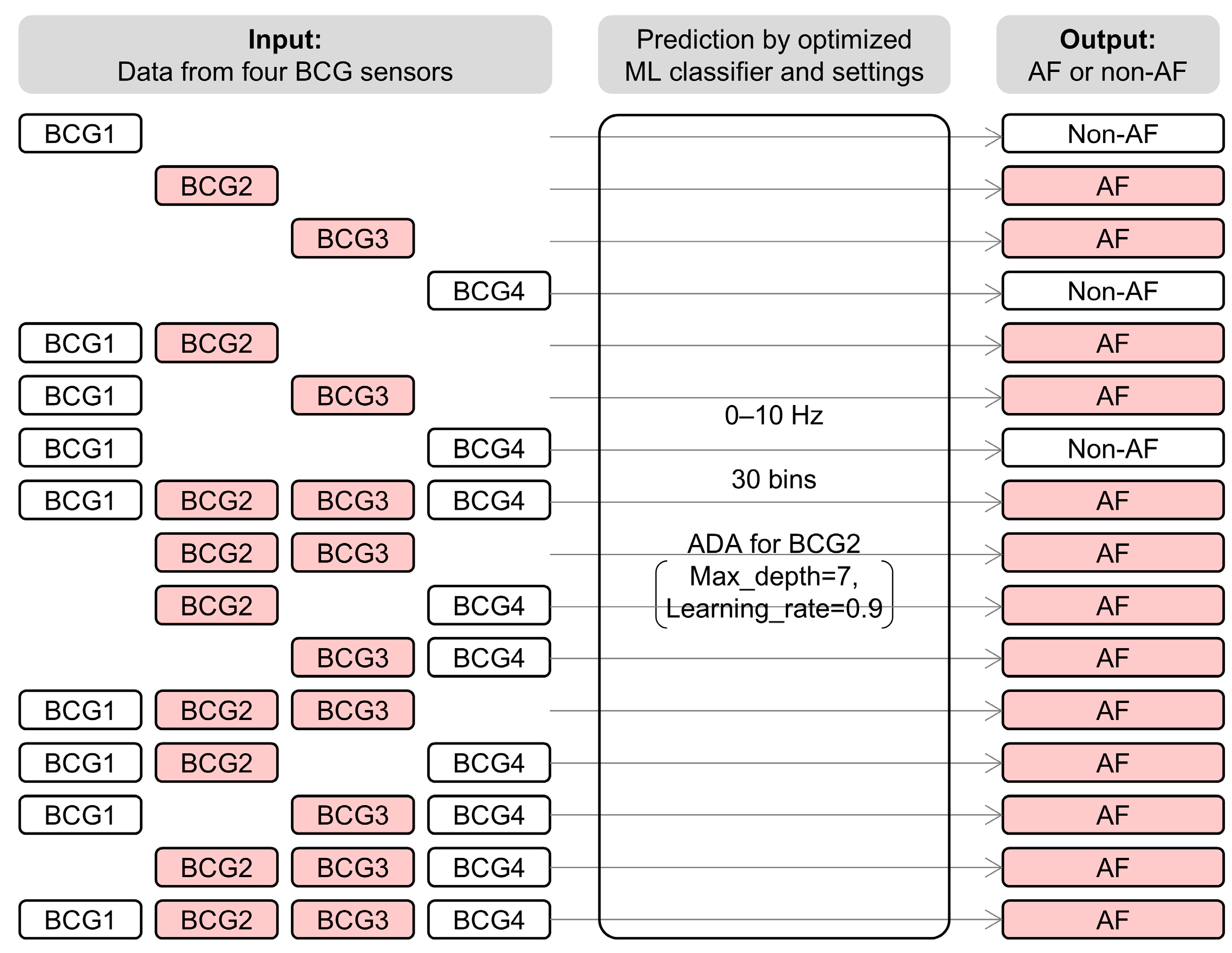
| Variables | Configurations | ||
|---|---|---|---|
| Frequency ranges input into ML classifier (Hz) | High cutoff frequency | 10, 20, 40, 250 | |
| Low cutoff frequency | 0, 0.5, 0.7, 1.0, 1.2 | ||
| Number of bins | 3, 5, 10, 30, 40, 50, 100, 150 | ||
| Parameters | DT | max_depth | 1, 3, 5, 7, 10, 15 |
| RF | max_depth | 1, 3, 5, 7, 10, 15, 20, 25, 30, 40 | |
| LR | C | 10−8, 10−6, 10−4, 10−2, 1, 102, 104, 106, 108 | |
| ADA | learning_rate | 1.0, 0.9, 0.8 | |
| max_depth | 1, 2, 3, 4, 5, 6, 7, 8 | ||
| Estimator | DT | ||
| Training and Validation Datasets | Test Dataset | |||
|---|---|---|---|---|
| AF | Non-AF | AF | Non-AF | |
| Number of participants, n | 23 | 44 | 6 | 11 |
| Number of blocks, n | 1458 | 2868 | 396 | 712 |
| Age (years) | 75 ± 11 | 66 ± 20 | 75 ± 11 | 61 ± 28 |
| Male, n (%) | 15 (65) | 27 (61) | 5 (83) | 6 (55) |
| Height (cm) | 163 ± 10 | 164 ± 9 | 165 ± 13 | 159 ± 8 |
| Weight (kg) | 61 ± 15 | 59 ± 11 | 64 ± 15 | 54 ± 8 |
| Body mass index | 23 ± 4 | 22 ± 3 | 23 ± 3 | 21 ± 2 |
| Systolic blood pressure (mmHg) | 118 ± 20 | 120 ± 16 | 112 ± 8 | 124 ± 20 |
| Diastolic blood pressure (mmHg) | 76 ± 11 | 75 ± 11 | 74 ± 11 | 75 ± 9 |
| Heart rate (bpm) | 70 ± 10 | 64 ± 14 | 82 ± 10 | 67 ± 16 |
| BCG1 | ||||
| Maximum value of one block | 33,833 ± 736 | 33,690 ± 380 | 33,712 ± 603 | 33,962 ± 800 |
| Mean value of one block | 32,806 ± 6 | 32,806 ± 4 | 32,806 ± 3 | 32,806 ± 6 |
| Minimum value of one block | 31,680 ± 839 | 31,824 ± 585 | 31,818 ± 1001 | 31,658 ± 796 |
| BCG2 | ||||
| Maximum value of one block | 34,032 ± 1008 | 33,687 ± 568 | 33,694 ± 502 | 33,672 ± 400 |
| Mean value of one block | 32,794 ± 5 | 32,794 ± 5 | 32,794 ± 4 | 32,794 ± 4 |
| Minimum value of one block | 31,302 ± 1250 | 31,745 ± 712 | 31,531 ± 1156 | 31,784 ± 337 |
| BCG3 | ||||
| Maximum value of one block | 34,117 ± 2006 | 33,703 ± 849 | 33,679 ± 1178 | 33,570 ± 357 |
| Mean value of one block | 32,829 ± 11 | 32,830 ± 6 | 32,830 ± 4 | 32,830 ± 5 |
| Minimum value of one block | 31,509 ± 2174 | 31,950 ± 763 | 31,688 ± 2039 | 31,961 ± 525 |
| BCG4 | ||||
| Maximum value of one block | 33,790 ± 712 | 33,707 ± 533 | 33,869 ± 539 | 33,525 ± 339 |
| Mean value of one block | 32,803 ± 8 | 32,802 ± 6 | 32,802 ± 6 | 32,802 ± 4 |
| Minimum value of one block | 31,851 ± 1020 | 32,067 ± 525 | 31,799 ± 818 | 32,239 ± 257 |
| DT | RF | LR | ADA | |
|---|---|---|---|---|
| BCG1 | 0.83 | 0.85 | 0.88 | 0.89 |
| BCG2 | 0.85 | 0.90 | 0.87 | 0.91 |
| BCG3 | 0.81 | 0.83 | 0.82 | 0.82 |
| BCG4 | 0.76 | 0.73 | 0.74 | 0.74 |
| All sensors | 0.78 | 0.82 | 0.81 | 0.81 |
| BCG1 | BCG2 | BCG3 | BCG4 | All Sensors | |
|---|---|---|---|---|---|
| Best ML classifier | ADA | ADA | RF | DT | RF |
| Best settings | |||||
| Frequency ranges input into ML classifier (Hz) | 1.2–20 | 0–10 | 1–10 | 0.5–40 | 1–10 |
| Number of bins | 10 | 30 | 50 | 3 | 100 |
| Parameters | max_depth = 1, learning_rate = 0.8 | max_depth = 7, learning_rate = 0.9 | max_depth = 10 | max_depth = 3 | max_depth = 30 |
| Accuracy during the five-fold CV on validation dataset 1 | 0.89 | 0.91 | 0.83 | 0.76 | 0.82 |
| Accuracy during the leave-one-participant-out CV on validation dataset 2 | 0.83 ± 0.29 | 0.86 ± 0.24 | 0.79 ± 0.30 | 0.75 ± 0.34 | 0.78 ± 0.24 |
| Scores on test dataset | |||||
| Accuracy | 0.61 | 0.88 | 0.81 | 0.75 | 0.82 |
| Recall | 0.32 | 0.72 | 0.56 | 0.42 | 0.69 |
| Specificity | 0.81 | 0.97 | 0.95 | 0.92 | 0.89 |
| Precision | 0.53 | 0.92 | 0.85 | 0.71 | 0.78 |
| F1 score | 0.40 | 0.81 | 0.67 | 0.53 | 0.74 |
| AUC | 0.66 | 0.89 | 0.80 | 0.79 | 0.84 |
| Included Blocks, n (%) | Mean Accuracy During the Five-Fold CV on Validation Dataset | ||
|---|---|---|---|
| Raw BCG amplitude-based threshold | |||
| 33,500 | 1502 (35) | 0.87 | |
| 34,000 | 3310 (77) | 0.91 | |
| 34,500 | 3971 (92) | 0.84 | |
| 35,000 | 4177 (97) | 0.84 | |
| 35,500 | 4217 (97) | 0.84 | |
| 36,000 | 4249 (98) | 0.85 | |
| Standardized BCG amplitude-based threshold | |||
| 3 | 1988 (46) | 0.87 | |
| 3.4934 | 3310 (77) | 0.86 | |
| 4 | 3825 (88) | 0.86 | |
| 5 | 4124 (95) | 0.82 | |
| 6 | 4214 (97) | 0.85 | |
| Scores | ML Classifiers | Test Dataset | |||
|---|---|---|---|---|---|
| BCG1 | BCG2 | BCG3 | BCG4 | ||
| Accuracy | ADA for BCG1 | 0.61 | 0.62 | 0.68 | 0.69 |
| ADA for BCG2 | 0.92 | 0.88 | 0.73 | 0.78 | |
| RF for BCG3 | 0.75 | 0.75 | 0.81 | 0.70 | |
| DT for BCG4 | 0.63 | 0.70 | 0.65 | 0.75 | |
| RF for all sensors | 0.84 | 0.90 | 0.78 | 0.76 | |
| Recall | ADA for BCG1 | 0.32 | 0.04 | 0.11 | 0.25 |
| ADA for BCG2 | 0.96 | 0.72 | 0.29 | 0.41 | |
| RF for BCG3 | 0.78 | 0.84 | 0.56 | 0.65 | |
| DT for BCG4 | 0.73 | 0.97 | 0.49 | 0.42 | |
| RF for all sensors | 0.90 | 0.83 | 0.47 | 0.58 | |
| Specificity | ADA for BCG1 | 0.81 | 0.94 | 1.00 | 0.90 |
| ADA for BCG2 | 0.88 | 0.97 | 0.99 | 0.96 | |
| RF for BCG3 | 0.74 | 0.70 | 0.95 | 0.73 | |
| DT for BCG4 | 0.57 | 0.54 | 0.75 | 0.92 | |
| RF for all sensors | 0.79 | 0.94 | 0.96 | 0.85 | |
| Precision | ADA for BCG1 | 0.53 | 0.29 | 0.93 | 0.56 |
| ADA for BCG2 | 0.85 | 0.92 | 0.92 | 0.84 | |
| RF for BCG3 | 0.66 | 0.60 | 0.85 | 0.54 | |
| DT for BCG4 | 0.53 | 0.54 | 0.52 | 0.71 | |
| RF for all sensors | 0.75 | 0.88 | 0.88 | 0.65 | |
| F1 score | ADA for BCG1 | 0.40 | 0.07 | 0.20 | 0.35 |
| ADA for BCG2 | 0.90 | 0.81 | 0.44 | 0.55 | |
| RF for BCG3 | 0.72 | 0.70 | 0.67 | 0.59 | |
| DT for BCG4 | 0.61 | 0.69 | 0.50 | 0.53 | |
| RF for all sensors | 0.82 | 0.86 | 0.61 | 0.61 | |
| AUC | ADA for BCG1 | 0.66 | 0.60 | 0.87 | 0.61 |
| ADA for BCG2 | 0.95 | 0.89 | 0.75 | 0.82 | |
| RF for BCG3 | 0.82 | 0.84 | 0.80 | 0.73 | |
| DT for BCG4 | 0.69 | 0.78 | 0.68 | 0.79 | |
| RF for all sensors | 0.90 | 0.94 | 0.86 | 0.71 | |
| BCG Data Used for Analysis | Included Blocks, n (%) | Scores | ||||
|---|---|---|---|---|---|---|
| Accuracy | Recall | Specificity | Precision | F1 Score | ||
| 1 | 838 (76) | 0.92 | 0.96 | 0.88 | 0.85 | 0.90 |
| 2 | 982 (89) | 0.88 | 0.72 | 0.97 | 0.92 | 0.81 |
| 3 | 1017 (92) | 0.73 | 0.29 | 0.99 | 0.92 | 0.44 |
| 4 | 917 (83) | 0.78 | 0.41 | 0.96 | 0.84 | 0.55 |
| 1, 2 | 1013 (91) | 0.92 | 0.98 | 0.89 | 0.84 | 0.90 |
| 1, 3 | 1025 (93) | 0.92 | 0.95 | 0.90 | 0.84 | 0.89 |
| 1, 4 | 1057 (95) | 0.90 | 0.92 | 0.88 | 0.80 | 0.86 |
| 2, 3 | 1069 (96) | 0.91 | 0.83 | 0.96 | 0.91 | 0.87 |
| 2, 4 | 1077 (97) | 0.88 | 0.78 | 0.94 | 0.86 | 0.82 |
| 3, 4 | 1083 (98) | 0.82 | 0.55 | 0.96 | 0.87 | 0.67 |
| 1, 2, 3 | 1069 (96) | 0.92 | 0.99 | 0.89 | 0.83 | 0.90 |
| 1, 2, 4 | 1090 (98) | 0.90 | 0.95 | 0.87 | 0.80 | 0.87 |
| 1, 3, 4 | 1083 (98) | 0.91 | 0.96 | 0.88 | 0.81 | 0.88 |
| 2, 3, 4 | 1090 (98) | 0.91 | 0.87 | 0.93 | 0.87 | 0.87 |
| 1, 2, 3, 4 | 1090 (98) | 0.90 | 0.98 | 0.86 | 0.79 | 0.88 |
| Study | Koivisto et al. (2019) [12] | Jiang et al. (2021) [13] | Cheng et al. (2022) [14] | Sandelin et al. (2025) [15] | Our Study | |
|---|---|---|---|---|---|---|
| ADA for BCG2 | Combination Analysis of BCG1 and BCG2 | |||||
| Signal | BCG | BCG | BCG | BCG | BCG | |
| Sensor | MEMS accelometer based sensor | Piezoelectric film sensor | Piezoelectric film sensor | Pressure-sensitive mat | Piezoelectric rubber sheet sensor | |
| Posture | Lying position | Lying position | Lying position | Supine position | Supine position | |
| Cohort size | 20 AF and 15 healthy participants. | 2000 (AF:1000, non-AF:1000) segments from 59 patients with PAF. 80% of segments were used for training, and 20% of segments were used for test. | 4000 (AF:2000, non-AF:2000) segments from 59 patients with PAF. 80% of segments were used for training, and 20% of segments were used for test. | 72 (AF: 32, SR: 40) participants for training, and 44 (AF: 22, SR: 22) participants for test. | 3310 (AF: 918, non-AF: 2392) blocks from 67 participants for training, and 982 (AF: 348, non-AF: 634) blocks from 17 participants for test. | 3310 (AF: 918, non-AF: 2392) blocks from 67 participants for training, and 1013 (AF: 367, non-AF: 646) blocks from 17 participants for test. |
| Best performance | ||||||
| Accuracy | - | 0.95 | 0.96 | 0.91 | 0.88 | 0.92 |
| Recall | 1.00 | 0.95 | 0.96 | 0.94 | 0.72 | 0.98 |
| Specificity | 0.93 | 0.94 | 0.96 | 0.86 | 0.97 | 0.89 |
| Precision | - | 0.94 | 0.96 | 0.93 | 0.92 | 0.84 |
| F1 score 1 | - | 0.94 | 0.96 | 0.93 | 0.81 | 0.90 |
| AUC | 1.00 | - | - | 0.97 | 0.89 | - |
| Study | Pachori et al. (2024) [20] | Jafari Tadi et al. (2019) [19] | Liu et al. (2024) [21] | Zhao et al. (2024) [22] | ||
| Signal | PPG | MCG (SCG + GCG) | Acoustic sensing | Millimeter wave | ||
| Sensor | Bedside monitor | Built-in accelerometer and gyroscope in smartphone | Built-in microphones and speakers in smartphone | Millimeter wave radar | ||
| Posture | (Publicly available dataset) | Supine position | - | Lying position | ||
| Cohort size | 35 (AF:19, non-AF: 16) participants for 10-fold CV. 4200 samples were used for training, and 4200 samples were used for validation. | 300 (AF: 150, SR: 150) participants for training, and 135 (AF:40, SR: 95) participants for test. | 764 valid data pieces (AF: 27.9%, non-AF: 72.1%) from 20 participants for leave-one-participant-out CV. | 5 s window with 1 s sliding × a total duration of 26.6 h data (arrhythmia: 20.7%, normal sinus rhythm: 79.8%) from 20 participants. 70% were used for training, 10% were used for validation, and 20% were used for test. | ||
| Best performance | ||||||
| Accuracy | 0.99 | 0.95 | 0.93 | 0.97 2 | ||
| Recall | 0.99 | 0.90 | 0.87 | 0.92 2 | ||
| Specificity | 0.99 | 0.97 | - | 0.99 2 | ||
| Precision | - | 0.92 | 0.87 | 0.95 2 | ||
| F1 score 1 | 0.99 | 0.96 | 0.87 | 0.93 2 | ||
| AUC | 1.00 | - | - | 1.00 2 | ||
Disclaimer/Publisher’s Note: The statements, opinions and data contained in all publications are solely those of the individual author(s) and contributor(s) and not of MDPI and/or the editor(s). MDPI and/or the editor(s) disclaim responsibility for any injury to people or property resulting from any ideas, methods, instructions or products referred to in the content. |
© 2025 by the authors. Licensee MDPI, Basel, Switzerland. This article is an open access article distributed under the terms and conditions of the Creative Commons Attribution (CC BY) license (https://creativecommons.org/licenses/by/4.0/).
Share and Cite
Hamada, S.; Amemiya, M.; Sasano, T. Detection of Atrial Fibrillation Using Multi-Site Ballistocardiogram with Piezoelectric Rubber Sheet Sensors. Sensors 2025, 25, 6833. https://doi.org/10.3390/s25226833
Hamada S, Amemiya M, Sasano T. Detection of Atrial Fibrillation Using Multi-Site Ballistocardiogram with Piezoelectric Rubber Sheet Sensors. Sensors. 2025; 25(22):6833. https://doi.org/10.3390/s25226833
Chicago/Turabian StyleHamada, Satomi, Miki Amemiya, and Tetsuo Sasano. 2025. "Detection of Atrial Fibrillation Using Multi-Site Ballistocardiogram with Piezoelectric Rubber Sheet Sensors" Sensors 25, no. 22: 6833. https://doi.org/10.3390/s25226833
APA StyleHamada, S., Amemiya, M., & Sasano, T. (2025). Detection of Atrial Fibrillation Using Multi-Site Ballistocardiogram with Piezoelectric Rubber Sheet Sensors. Sensors, 25(22), 6833. https://doi.org/10.3390/s25226833






